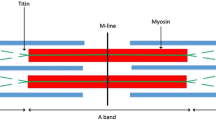Electromyograms were recorded from the main chewing muscles (mm. masseter and temporales) in 184 patients suffering from dysfunction of the temporomandibular joints and 25 healthy subjects (controls). In the patient group, the mean duration of the silence phase in cyclic EMG activity of the above muscles related to normal chewing (293.8 msec, a value averaged for all examined muscles and all examined patients) was by about 30% smaller than the analogous value in the control group. At the same time, the mean duration of the activity phase did not differ significantly from that in the control. The ratio of durations of the activity vs. silence phases in the patient group was 1.352, as compared with 0.946 in control subjects. The mean duration of the chewing cycle (also totally averaged for the patients) was 691.1 sec vs. 814.4 msec in the control; the respective mean values of the chewing frequency in the above groups were 1.447 and 1.228 sec–1. The results obtained confirm the statement that parameters of functioning of the brainstem neuronal central pattern generator (CPG), a neuronal network responsible for generation of cyclic motor commands for chewing muscles, can be significantly modified under the influence of a changed afferent inflow, especially in the case where the latter contains a considerable nociceptive component related to the dysfunctional state of the temporomandibular joints.
Similar content being viewed by others
References
K. I. Afrashtehfar and S. Qadeer, “Computerized occlusal analysis as an alternative occlusal indicator,” Cranio, 34, No. 1, 52–57 (2016).
T. Kostiuk, I. Koval, D. Tyshko, and M. Koval, “Analysis of diagnostics and newest pathogenesis aspects of temporomandibular dysfunction (review),” Georgian Med. News., Nos. 280–281, 44–48 (2018).
M. Igić, N. Krunić, L. Aleksov, et al., “Determination of vertical dimension of occlusion by using the phonetic vowel “O” and “E”,” Vojnosanit. Pregl., 72, No. 2, 123– 131 (2015).
D. Manfredini, F. Cocilovo, L. Favero, et al., “Surface electromyography of jaw muscles and kinesiographic recordings: diagnostic accuracy for myofascial pain,” J. Oral Rehabil., 38, No. 11, 791–799 (2011).
A. Silveira, S. Armijo-Olivo, I.C. Gadotti, and D. Ma-gee, “Masticatory and cervical muscle tenderness and pain sensitivity in a remote area in subjects with a temporomandibular disorder and neck disability,” J. Oral Facial Pain Headache, 28, No. 2, 138–146 (2014).
E. Ferendiuk, K. Zajdel, and M. Pihut, “Incidence of otolaryngological symptoms in patients with temporomandibular joint dysfunctions,” Biomed. Res. Int., 2014, 824684 (2014).
H. Karibe, G. Goddard, and M. Okubo, “Comparison of masticatory muscle myofascial pain in patients with and without a chief complaint of headache,” Cranio, 32, No. 1, 57–62 (2014).
V. O. Malanchuk, O. S. Volovar, N. M. Timoshchenko, and T. M. Kostiuk, “Diagnostics of position of the motor and trigger points: of the chewing muscles for zygomatic complex fractures [in Ukrainian],” Lik. Sprava, Nos. 3–4, 109–115 (2015).
R. M. Furlan, R. S. Giovanardi, A. T. Britto, and D. B. Oliveira e Britto, “The use of superficial heat for treatment of temporomandibular disorders: an integrative review,” Codas, 27, No. 2, 207–212 (2015).
T. M. Kostiuk, Yu. Yu. Moroz, and V. P. Nespryad’ko, “EMG activity of the chewing muscles during adaptation of dental patients to fixed dentures,” Neurophysiology, 50, No. 3, 80–82 (2018).
Author information
Authors and Affiliations
Corresponding author
Rights and permissions
About this article
Cite this article
Kostiuk, T.M., Kaniura, A.A., Shinchukovskiy, I.A. et al. EMG Activity of Chewing Muscles in Dysfunctional Disorders of Temporomandibular Joints. Neurophysiology 52, 43–48 (2020). https://doi.org/10.1007/s11062-020-09849-2
Received:
Published:
Issue Date:
DOI: https://doi.org/10.1007/s11062-020-09849-2




